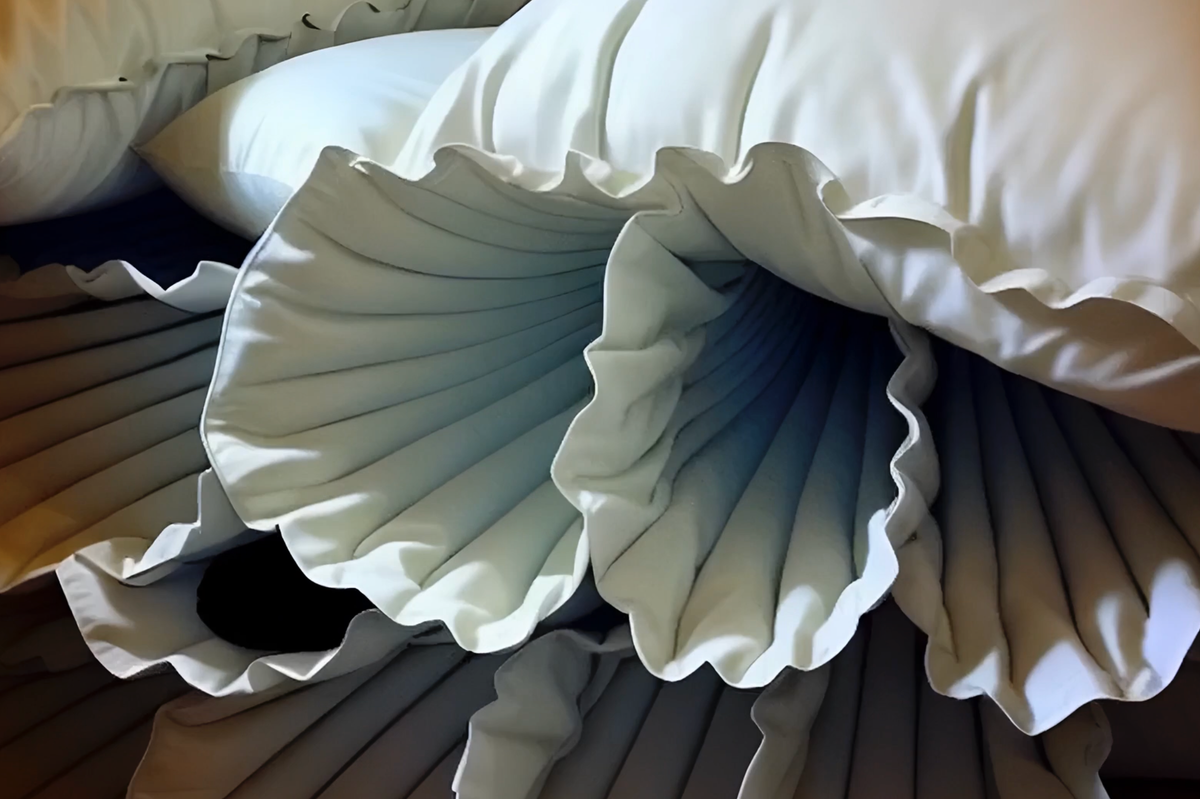Lifestyle
Harriet Brewis
Mar 17, 2024
Can We Adjust the Amount of Time We Spend Dreaming?
content.jwplatform.com
We’re constantly told that augmented reality, virtual reality and even mixed reality are going to be the next big thing, and that we should prepare for a world where the imaginary and the concrete are intrinsically, and indistinguishably, linked.
Just picture what it’d be like to enhance the world you live in, or travel to places you’ve always longed to visit, at the flick of a switch or, even, using an implant in your brain.
The thing is, we’re already equipped to create and control our own dreamscapes, and people have been doing it for millennia.
Lucid dreaming is the mind’s very own brand of VR and it requires no headset or microchip.
Put simply, it occurs when the sleeper is aware that they’re dreaming, meaning they’re able to direct what happens in the dream.
So are there any real benefits to lucid dreaming? And can you train yourself to do it?
One top London hotel certainly thinks so, and now it is boasting of “shaking up sleep tourism” by offering an in-room lucid dreaming experience.

Guests at the Kimpton Fitzroy, on Russell Square, are invited to book the hotel’s “Room to Dream” experience which, it claims, both provides “the necessary tools and steps to begin lucid dreaming”, and “teaches you how to explore the dream realm.”
The package features a selection of “lucid dream enhancing products” including a herbal tea, drops, and a pillow mist, and a “dream journal” which contains instructions on how to construct a lucid dream.
As part of this planning process, you are encouraged to ask yourself probing questions such as: “What fantasy would you like to experience?” And: “What part of your psyche would you like to heal?”
Then, once your dream plan is set, you are urged to strap yourself into a VR headset.
This then plays a five-minute-long, AI-generated video, whose purpose is to help you enter hypnagogia – the transitional state between wakefulness and sleep.
Of course, the burning question is… does this all work? And to answer it, I booked myself a room at the hotel.

I found the “Room to Dream” equipment in a leather-bound trunk at the base of my bed, tastefully arranged on a bed of emerald silk.
After rifling through the products, I rubbed some Lab Tonica “unplugged” sleep balm onto my pressure points as instructed, and dosed myself with some valerian-laced “lucid dream drops”.
I then dived straight in with the Oculus Rift headset, battling to get the handheld controllers to work and somehow ending up with a massive watermark obscuring my line of sight reading: “THIS IS A FREE TRIAL.”
So far, not so dreamy. Instead, I fumed at modern technology. Or, more accurately, my failure to get the damned thing to work.
Eventually, after nearly throwing the goggles across the room and calling the whole thing off, I managed to calm down and fix the display.
The video then presented a trippy landscape, featuring rolling lines of pink clouds, dew-kissed flowers and sun-drenched meadows, all melting, bubbling and transforming into one another.
This was accompanied by some suitably soothing synth music, and the soporific tones of a female narrator who welcomed me to my “next dream”.

According to the journal, I was now to remove my bulky eye mask and go to sleep – or rather, to hypnagogia – and then note down any dreams I had.
The issue was, by this point, it was 11.30pm and I’d been suffering insomnia for weeks, so I was in need of some proper shut-eye, rather than a slow drifting off into the “liminal space between our world and the dream world,” as the journal put it.
In other words, I wasn’t feeling too optimistic about my lucid dreaming potential.
And yet, what felt like a few seconds into settling down, I suffered a hypnic jerk: that startling feeling when your body suddenly twitches you awake just as you’re falling asleep.
The next morning, I jotted down in the journal that I had, indeed, dreamt. Admittedly it wasn’t a lucid dream, but it was still an extension of the whole “Room to Dream” experience.
My dream was set in the psychedelic landscape of the VR video, except this time it had a sinister twist: rather than enjoying the marshmallow clouds and breeze-tickled fields of before, I was wandering through the grass, stealing food to feed my family.

But whatever Freud may have made of my unconscious vision, the point is, I dreamt, and I experienced a brief moment of awareness in the hypnagogic state.
This has made me wonder, if I could achieve this in just one night (after, let’s be honest, a far from perfect adherence to the dream journal’s instructions), could I train myself to be a bonafide lucid dreamer with a bit more time and attention? And what, ultimately, would I gain by doing this?
What are the benefits?
“There are so many benefits to lucid dreaming,” sleep expert Charlie Morley told me. “But, in a nutshell, once you become conscious within your unconscious mind you can – much like through hypnotherapy – make lasting changes to your body and mind while you sleep.
“A few of my favourite benefits of lucid dreaming include: the healing of trauma and phobia; the treatment of PTSD; enhanced learning and access to past memory.
“There's also science showing that athletes can use lucid dreaming to practise their athletic discipline and get better at it.
“For example, in one study, 81.3 per cent of martial artists got better at martial arts by training in their lucid dreams.”
Charlie then pointed out that, similar to therapies using hypnosis or psychedelics, lucid dreaming can help form new neural connections in the brain.
“Basically, on a scientific level, when you get lucid in a dream, the prefrontal cortex becomes reactivated,” he explained.
“Once this occurs, neuroplasticity is engaged, meaning that in a lucid dream you can actually rewire your brain – you can lay down new neural pathways.”
Charlie, a published author who has led talks at the universities of Oxford and Cambridge, the Minsitry of Defence and the NHS, has spent the past couple of years working with military veterans and survivors of post traumatic stress disorder and/or childhood sexual abuse.
He also facilitated a study, published in the journal Traumatology in June 2023, in which 85 per cent of participants, who had been diagnosed with PTSD, experienced a significant decrease in their symptoms by using lucid dreaming to transform their nightmares.
The progress was so swift and profound that, by the end of the sixth day of the study, more than 85 per cent of the participants were no longer classified as having PTSD.

So why has it taken so long for people to show a substantive interest in lucid dreaming?
“When I started teaching lucid dreaming 15 years ago, no way would you have seen someone talking about it at the Ministry of Defence, no way would the NHS have been hosting a training day about it,” Charlie said.
“But the science is here, and now we've got the evidence to back up a thousand years of spiritual practice. Because lucid dreaming is a big thing in Tibetan Buddhism, it’s a big thing in Sufism – it goes back a long way in different shamanic traditions.
“I just think now people are more focused on how we can optimise our happiness and wellness, so they’re more cognisant of the power of sleep and dreams.”
He continued: “I also think it's a generational thing. Lucid dreaming is easier for younger people because they have, longer dream periods, and I think the TikTok generation, for example, are much more open to the power of these treatments.
“Certainly an interest in consciousness – including the subconscious and unconscious – has grown over the past 10 years thanks to the concept of mindfulness, and this has developed into an awareness of the potential of psychedelic therapy and lucid dreaming.
“Plus, people seem to be more willing, or ready, to talk about mental health issues and depression – to be able to say, “Yes, I have trauma and I’m working with it.”
But do you really need a VR set to enter the so-called “dream realm”?
“As far as the lucid dreaming part goes, the headset isn't actually needed,” Charlie, who helped devise the Kimpton Fitzroy’s “Room to Dream” experience confirmed.
“It was included because there are a lot of links between VR and Lucid dreaming.
He explained: “People who play a lot of video games, and especially people who spend a lot of time in virtual reality, tend to have more lucid dreams because we dream about what we do in the daytime.
“So if you spend time in a reality that isn’t real but looks real to your brain, you are creating the same kind of pathway that will lead to lucid dreams. So that was the aim with the headset.”
Plus, ultimately, he and the hotel team wanted to make the whole thing an enjoyable and memorable experience.
“The time it takes to teach yourself how to lucid dream completely depends on the person – for some people it can take one night, for others a few days, and for others a few weeks, but so much of it is about setting your intention and being in the right environment,” he said. “So with the 'Room to Dream' experience, we wanted to create the kind of ritualistic setting that’s conducive to lucid dreaming.
“We wanted it to make sure that even if guests couldn't actually get lucid on their first night, they could still see how the combination of the tea, the scents and the journaling could bring about that kind of experience.”

Still, Charlie stressed, an important thing to remember is that lucid dreaming is, ultimately, a lot of fun.
“You wake up in your dreams and you can fly, you can meet movie stars, you can walk through walls, you can experience crazy sexual stuff – you’re in control of the narrative,” he said.
“Yes, I mainly focus on the wellbeing and trauma integration side of things, but it’s also really cool.
“And, finally,” he added, “People are waking up to that.”
Sign up for our free Indy100 weekly newsletter
Have your say in our news democracy. Click the upvote icon at the top of the page to help raise this article through the indy100 rankings
Top 100
The Conversation (0)














